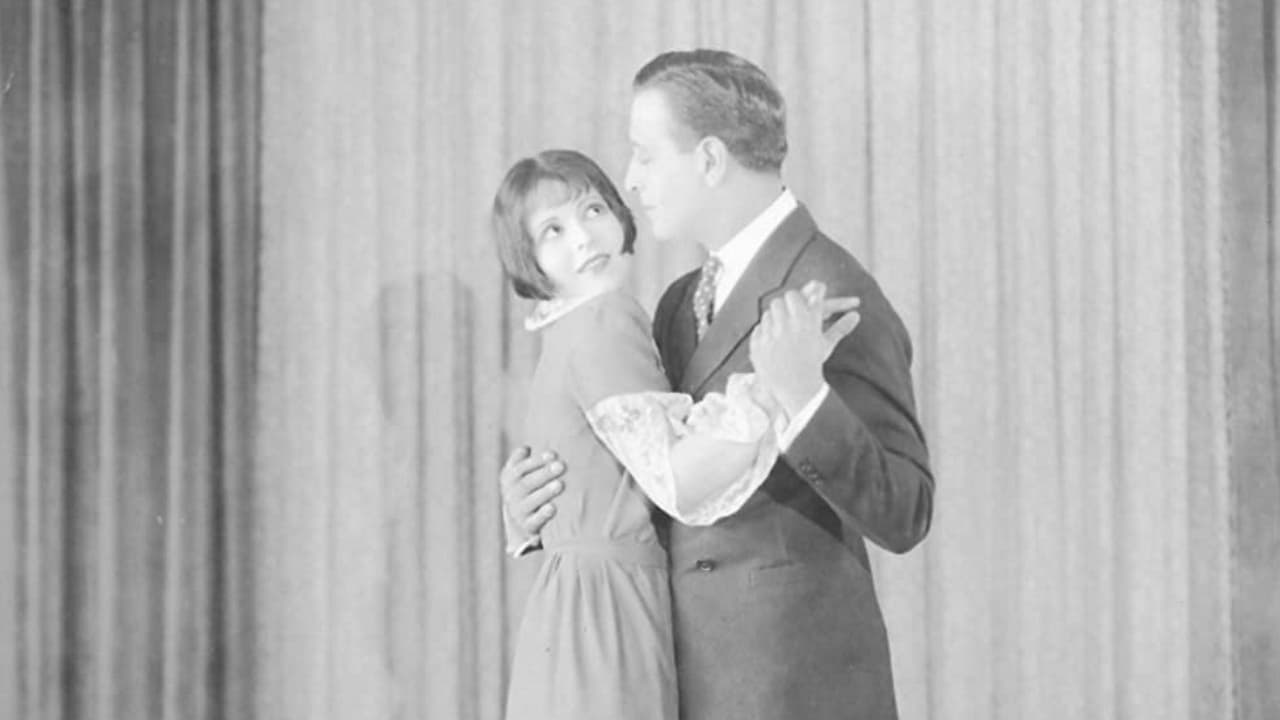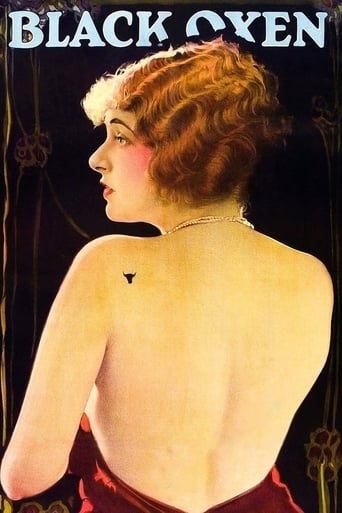



That was an excellent one.
Some things I liked some I did not.
Just so...so bad
The movie's neither hopeful in contrived ways, nor hopeless in different contrived ways. Somehow it manages to be wonderful
View MoreBlack Oxen is a remarkable film largely because it is based on a remarkable book, by Gertrude Atherton, and is (as far at any rate as the part that survives is concerned) quite a faithful representation of the novel."Rejuvenation" in its general usage during the period was something of a euphemism and was extremely male-oriented (in effect the "viagra" of its day). The interest in the potential effects of what would eventually be identified as testosterone goes back in some ways way into folklore but its "scientific" application began with a very eccentric French physiologist called Charles-Édouard Brown-Séquard who claimed in 1899 to have regained his youth after injecting himself with filtered extracts from the crushed testicles of young dogs and guinea pigs. In the 1920s and 1930s, Russo-French surgeon Serge Voronoff developed a technique for grafting monkey testicle tissue onto the testicles of men for a similar purpose, but is was the very distinguished endocrinologist Eugen Steinach whose work created the most interest.Steinach believed that what he called the "Steinach vasoligature" for men (a partial vasechtomy) would effect a rejuventaion and, although the emphasis still remained largely on men and on sexual potency; poet W. B. Yeats, from one of whose verse-plays the title of the book and film comes, was the best-known celebrity to have been "steinached" and to have claimed a rejuvenation and a re-energisation as a result. Steinach did however extend his theory to women, the equivalent being an irradiation of the ovaries (which also rendered the woman infertile) and Atherton was herself one of those who had undergone the treatment and she too claimed to have benefited significantly from it and it was the inspiration for the novel.This was the time when cosmetic surgery was also coming of age - many people know that actress Sarah Bernhardt had to have her leg amputated but fewer know that she had had had a face-life shortly before that. This was also the time when the generation-gap was beginning to be talked about and seemed in the era of "flapper" 9represented of course by Clara Bow in the film) to create a particularly harsh divide where women were concerned. Atherton believed that Steinach rejuvenations were a form of female empowerment (many women would claim the same today for cosmetic surgery) and she uses the idea of rejuvenation in her novel to review a whole range of related subjects - the situation of the old, the generation gap, the sexuality of women.In the first part of the film (the part that survives) this is fairly well represented by Lloyd but if the ending of the film is (as some reviewers claim) predictable, it should not be because it is not at all the same as the ending of the book. Lloyd plumps in fact for a much more conventional view that has the heroine agreeing to "act her age" (and in effect "know her place")while the hero goes off with the flapper. Corinne Griffith gives I think a very impressive and subtle performance as a woman with a mature mind but a young body (the ideal as Atherton perceived it) but, in life, as in the film, it was the young Clara Bow (whose performance is nothing remarkable) who proved the eventual beneficiary.It is thought that the film in its entirety is not beyond the possibilities of being Steinached but given the disappointing ending, it is perhaps better the way it is.
View MoreThis film version of 65 year-old feminist writer Gertrude Atherton's controversial 1923 novel based upon her own treatment with an early form of hormone transplantation was on cinema screens by the end of the year and generated a lot of discussion at the height of the flapper era; and it remains topical today with the advent of HRT and current journalistic buzz about Cougars and toy boys.Aged 45 (but like many matinée idols of the era looking much older), Conway Tearle as eligible bachelor Lee Clavering has the dilemma that dizzy flappers like Janet Ogelthorpe (played by Clara Bow) bore him, yet has "a vague idea that Autumnal love is - is rather indecent". He indeed looks pretty long in the tooth for 28 year-old Corinne Griffith as the mysterious Mary Ogden, referred to in the opening credits simply as "The Woman"; about whom an awful lot of footage is squandered upon speculation as to her true identity until she finally fesses up and confirms that she is really sixty year-old Madame Zatianny. In a flashback in which she is supposed to be in her late fifties, but is made up and shuffles about like an infirm eighty year-old, she is rejuvenated in Austria by a medical procedure that is alluded to only very vaguely.At this point it gets interesting, as her old friends digest the implications of this revelation; notably Claire McDowell as Agnes Trevor, who bitterly regrets her own lost opportunities to find love when young and thus sorely envies Madame Zatianny the second chance her treatment has gifted her. (McDowell was actually less than six months older than Tearle and would probably have benefited enormously just from a more contemporary makeup and wardrobe like Griffith's.) Unfortunately, with twenty minutes still to go this is the point at which the only currently available version of 'Black Oxen' abruptly ends. Or maybe it's not so unfortunate. We know from original reviews that her old Austrian beau Prince Rohenhauer (played by Alan Hale) shows up, persuades her to act her age and return with him to Austria, leaving Lee to find true happiness with the flapper who had so bored him earlier, provoking 'Variety's original reviewer to ironically state that the film's "only fault seems to be the disappointing ending".An epilogue to 'Black Oxen' that proves yet again how much stranger real life can be even than a silent movie came in 1966 (the year that Claire McDowell died at the age of 88) when 72 year-old Griffith divorced her 45 year-old fourth husband of a few days and testified in court (contradicting testimony from Betty Blythe and Claire Windsor, who had both known her during the 1920s) that she was not Corinne Griffith, but her younger sister who had taken her place upon her elder sibling's death.
View MoreAt the opening of "The Undesired", a New York play, the audience is stunned by the incredible beauty of Corinne Griffith, who simply stands up from her seat. Brilliant theater critic, and budding playwright, Conway Tearle (as Lee Clavering) is among those smitten by the ravishing Ms. Griffith. Mr. Tearle insists he must meet her. Elderly gossip Tom Ricketts (as Charles Dinwiddie) is more shocked than enthralled, because the mysterious young woman looks exactly like a lady he dated 30 years ago; Mr. Ricketts explains the woman was "Mary Ogden", who should be old and feeble, presently. Griffith claims to be her lookalike's niece. But, old friend Kate Lester (as Jane Ogelthorpe) says "Mary Ogden" had no siblings.Griffith and Tearle fall in love. As things turn out, the originally hinted at science fiction angle is dispensed with. Before the film's "flashback", Griffith reveals she is "an old woman of sixty, whose youth has been restored to her by a modern miracle of science." This follows the explanation offered in writer Gertrude Atherton's autobiographical "Black Oxen" (1923). Ms. Atherton wrote about her own "youthful" restoration. The process, or "Steinach treatment", rejuvenated a woman's youth and vitality by X-raying her ovaries.Interestingly, in real life, actress Griffith employed a different (and, likely, more effective) "youth restoration" technique - she claimed to be her own much younger sister. On film, she looks lovely, but there isn't much depth in Griffith's characterization; she and Tearle essay a common romance. During the flashback, Griffith looks more tired than old; and, before the process, she doesn't look at all old enough to be a "woman of sixty".Griffith's reason for contemplating youth is not as interesting or realistic as supporting character Claire McDowell (as Agnes Trevor). Ms. McDowell's motivation would have made a more interesting film. A real "flaming youth", Clara Bow (as Janet Oglethorpe), plays a delightful young "flapper" who has a crush older man Tearle. The last quarter of "Black Oxen" is missing, but it's not too difficult to determine how it all ends. **** Black Oxen (12/29/23) Frank Lloyd ~ Corinne Griffith, Conway Tearle, Clara Bow
View More"Black Oxen" by Gertrude Atherton was the #1 best-selling novel of 1923, going through 14 printings in a single year. The novel gained a racy reputation, due to its (for the time) frank discussion of women's sexual organs, and because of some innovative language. (This novel featured the first use of the word "sophisticate" as a noun.) The film version was rushed into production almost immediately, but is well-made and not a quickie."Black Oxen" (the 1923 novel) is science fiction, although few of its readers realised that fact. The 1924 film "Black Oxen" is a science-fiction movie, but is not immediately recognisable as such because the film emphasises ideas rather than sci-fi gadgetry. The film takes its title from a verse by Yeats: "The years like great Black Oxen tread the world". A much later science-fiction novel, also cried 'Black Oxen' (by New Zealand author Elizabeth Knox, published in 2001), takes its title from this same source.Lee Clavering (played by Conway Tearle) is a handsome playboy in jazz-era Manhattan. (In the novel, Clavering was a playwright: in this movie, he allegedly writes a newspaper column, but seems to spend all his time carousing.) In a nightclub, he meets a mysterious Austrian beauty named Madame Zatianny (Corinne Griffith) and he's instantly attracted to her. Clavering's older friends Mr and Mrs Oglethorpe are also intrigued by Mme Zatianny, because she is an exact double for Mary Ogden, a socialite of the 1890s who disappeared in Europe many years ago. But Mary Ogden would now be 58 years old, whilst Mme Zatianny is a young woman. Can she perhaps be Mary Ogden's daughter?SPOILER COMING: As a romance develops between Clavering and Zatianny, he discovers the bizarre truth. Years ago, Mary Ogden went to Vienna and volunteered for a medical experiment, in which her ovaries were irradiated with radium treatments. This rejuvenated the fiftyish Mary, restoring her to the sexual vitality and physical youth of her early twenties. She re-invented herself as the European beauty Zatianny, and has now returned to her old haunts. For reasons never properly explained, the radium treatment works only on women, not men.This is a strange film, but an interesting one. In flashbacks, we see Mary Ogden as she looked in her fifties: the make-up on Corinne Griffith is not very convincing, and she looks as if she's in her seventies, not her fifties. Also, the movie implies that a woman in her fifties is hopelessly old, beyond any hope of emotional happiness. If this is true, it's down to social prejudice rather than biological fact.Clara Bow is good in a small role as the Oglethorpes' socialite daughter, and more subdued than usual. "Black Oxen" is a good example of how silent films sometimes had narrative advantages over talking films. Corinne Griffith has to play an American and a (supposed) European. In a sound film, she would have to speak her lines in two different accents. The European accent would probably have been a fairly ludicrous one, dispelling the credibility of her character. Because "Black Oxen" is a silent film, the accent problem is avoided.
View More